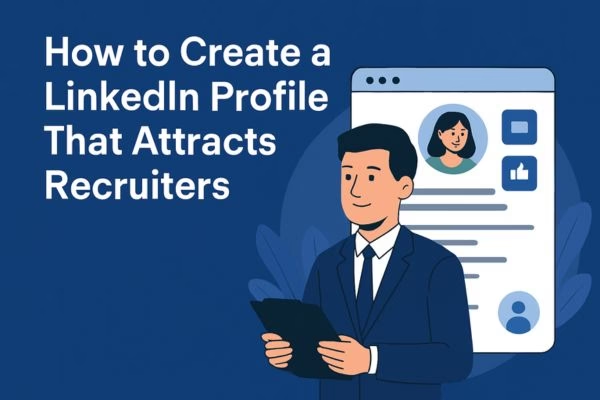LinkedIn is more than just a job history listing site in today’s digital age. It’s also a billboard for your professional brand. Recruiters scan hundreds of profiles daily, and the difference between getting noticed or passed over often comes down to how well you’ve presented yourself. How to Create a LinkedIn Profile question mark right follow this blog
Whether you’re job hunting or just open to opportunities, here’s a comprehensive guide to creating a LinkedIn profile that truly stands out and grabs the attention of recruiters.
1. Start With a Professional Profile Photo
First impressions count. Your profile photo is the first thing a recruiter sees, so make sure it’s sending the right message. Use a high-quality headshot with good lighting, a neutral background, and professional attire. Avoid selfies, filters, or casual shots — this is not Instagram.
Pro tip: Smile. People connect more with approachable, friendly faces.
2. Craft a Compelling Headline
Most people just use their job title here, but this is valuable real estate. You’ve got 220 characters to show off your skills, roles, or what you’re passionate about. Instead of just saying “Software Engineer,” try something like:
Software Engineer | Specialized in Front-End Development | Passionate About Scalable Web Apps
The goal is to make your headline descriptive, searchable, and relevant to the roles you’re targeting.
3. Write a Standout Summary (About Section)
Think of the summary as your elevator pitch. It’s your chance to tell your story — who you are, what you do, and where you’re headed. Keep it conversational, authentic, and focused. Highlight key achievements, strengths, and what makes you unique.
Avoid buzzwords like “go-getter” and “hard worker” unless you can back them up with real examples. Instead, show your personality and passion.
Structure suggestion:
- Start with a short intro.
- Mention your key skills or industries.
- Include accomplishments or experiences.
- Finish with what you’re looking for or open to.
4. Optimize Your Experience Section
This isn’t a copy-paste of your resume. Go beyond listing duties — focus on results and impact. Use bullet points to keep things readable. Include keywords recruiters in your industry might search for. Think about how you contributed to your team or company goals.
For each role:
- What did you do?
- How did you do it?
- What was the outcome?
Numbers help too. If you increased sales by 25% or reduced customer complaints by 40%, let that data speak for itself.
5. Showcase Skills (And Endorsements)
LinkedIn enables you to list up to 50 skills. Use them wisely. Focus on skills relevant to the jobs you’re interested in. Keep them up to date and organize your top three prominently — these are the ones recruiters see first.
Ask colleagues or past managers to endorse you for skills they’ve witnessed firsthand. It adds credibility.
6. Get Recommendations
Think of recommendations as public references. Reach out to former colleagues, clients, or supervisors and ask for short recommendations that highlight your work ethic, collaboration, or expertise.
It’s not about quantity — a few strong, specific ones can make a big difference.
7. Customize Your LinkedIn URL
A clean, custom LinkedIn URL (like linkedin.com/in/yourname) looks more professional and is easier to share. You can update this under your profile settings.
This small tweak shows attention to detail and enhances your personal branding.
8. Be Active and Engage
Having a great profile is only step one. To really catch a recruiter’s eye, you need to be active on the platform. That doesn’t mean posting every day, but liking relevant posts, sharing insights, and engaging in discussions can improve visibility.
Join industry-specific groups. Comment thoughtfully on posts. This helps position you as someone who’s active and engaged in your field.
9. Use the “Open to Work” Feature Wisely
LinkedIn has a feature that informs recruiters that you are open to new roles. You can make this visible to recruiters only or add the “#OpenToWork” banner on your profile photo.
Be specific about what roles you’re interested in and your preferred location or work type (remote, hybrid, in-office).
10. Keep It Updated
A LinkedIn profile is a living document. Make it a habit to update it regularly — whether it’s a new skill, certification, or project. Every small update keeps your profile fresh and relevant.
Final Thoughts
Recruiters are not just looking at qualifications; they’re looking for people who stand out, who show initiative, and who communicate their value clearly. By investing a bit of time into optimizing your LinkedIn profile, you’re making it easier for opportunities to find you.
Your LinkedIn is often your first impression — make it count.








